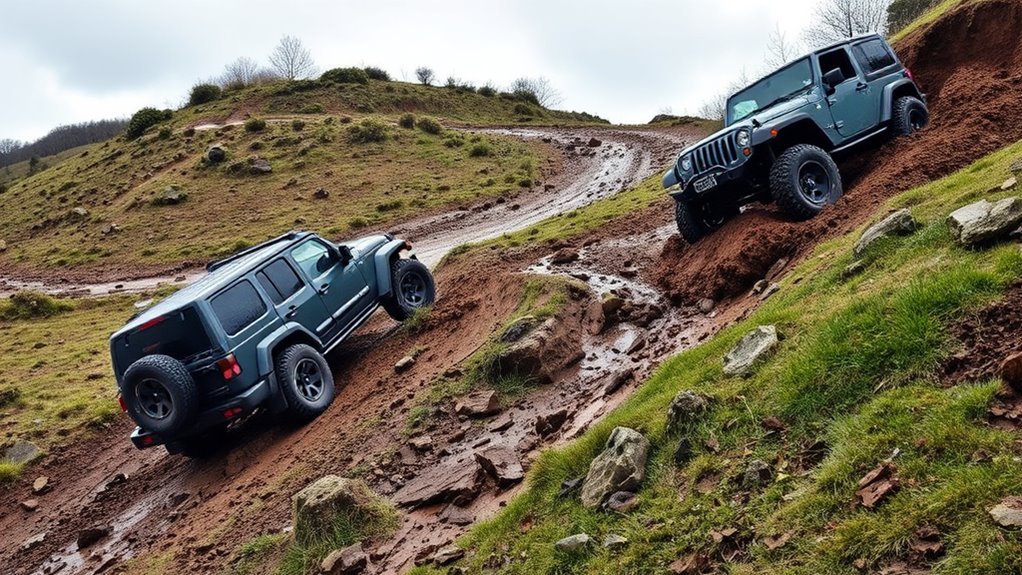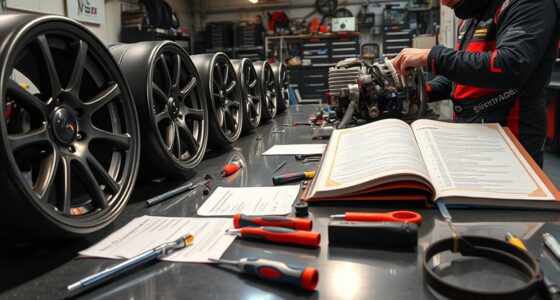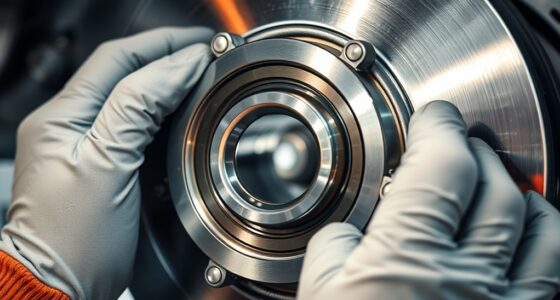While 4WD provides better traction off-road, it’s not always faster because it adds weight, making your vehicle less agile and responsive. The extra mechanical parts can slow you down, and the increased complexity raises the risk of breakdowns. In contrast, 2WD vehicles are lighter and simpler, often offering better maneuverability and efficiency. To discover how these factors impact off-road performance and why lighter setups can sometimes be better, keep exploring further.
Key Takeaways
- Heavier 4WD vehicles have increased inertia, reducing acceleration and agility compared to lighter 2WD models.
- Additional drivetrain components in 4WD add weight and complexity, which can hinder quick maneuvers and responsiveness.
- 2WD vehicles often have a smaller turning radius, allowing faster navigation through tight or obstacle-filled terrains.
- In many off-road conditions, 4WD’s extra traction isn’t needed, and its weight can slow overall progress.
- Proper tire choice and terrain conditions can make 2WD perform just as well or better in certain off-road scenarios.
The Impact of Vehicle Weight and Complexity

While heavier and more complex vehicles often provide better off-road capability, their added weight can also hinder performance and fuel efficiency. Heavier vehicles require more power to move, which strains the engine and consumes more fuel. The increased mass can make acceleration sluggish and reduce agility on uneven terrain. Additionally, complex systems like four-wheel drive and locking differentials add weight, sometimes making the vehicle less responsive. This extra weight also impacts braking distance, especially on steep descents. You might find that a lighter, simpler vehicle performs better in certain off-road conditions, offering better maneuverability and less strain on the engine. Ultimately, balancing weight and complexity is key to optimizing off-road performance without sacrificing efficiency.
Traction and Control in Different Terrains
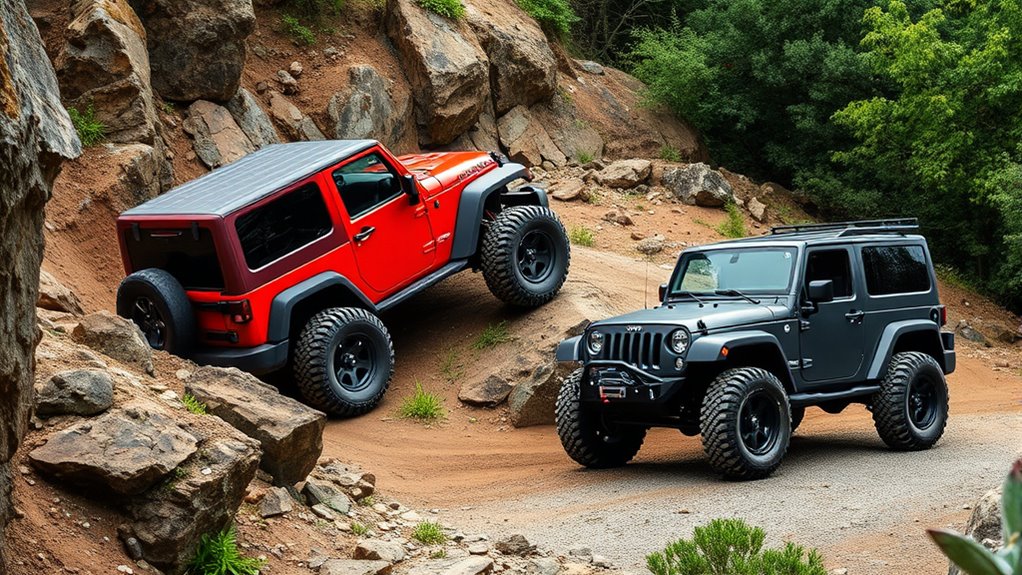
When driving off-road, you’ll notice that terrain type considerably affects your vehicle’s traction and control. Slippery surfaces like mud or snow challenge your grip, especially if weight distribution isn’t optimized. Understanding how vehicle weight and terrain adaptability impact your ride helps you stay in control no matter the conditions. For example, different terrain types may require adjustments to your traction or driving style to maintain optimal performance.
Terrain Adaptability Challenges
Controlling different terrains requires your vehicle’s traction and control systems to adapt quickly and effectively. 4WD systems typically distribute power to all four wheels, providing better grip on challenging surfaces like mud, snow, or loose gravel. However, terrain adaptability can still be tricky. Some surfaces demand more finesse than brute force, and not all 4WD setups handle every challenge seamlessly. You might find yourself struggling on uneven rocky paths or soft sand where wheel spin and loss of control occur. The table below highlights common terrains and their adaptability challenges:
| Terrain | Traction Challenge | Control Difficulty |
|---|---|---|
| Muddy Trails | Slipping and loss of grip | Steering becomes unpredictable |
| Snowy Surfaces | Reduced friction, slipping | Maintaining direction |
| Loose Gravel | Wheel spin, uneven traction | Stability and control |
Slippery Surface Dynamics
Steering through slippery surfaces demands precise traction management and responsive control systems. When you encounter mud, ice, or wet rocks, maintaining grip becomes crucial. Your vehicle’s tires must bite into the surface without spinning excessively, which can worsen slippage. In 2WD, power usually goes to the rear wheels, making it easier to lose control on slick surfaces, especially if the tires can’t find enough grip. 4WD systems can distribute torque to all four wheels, offering better traction and stability. However, if your tires aren’t suitable or you drive too aggressively, even 4WD can struggle. Smooth throttle inputs, gentle steering, and selecting appropriate driving modes help you stay in control. Understanding how your vehicle responds on slippery terrain allows you to adapt and avoid dangerous slips or spins.
Vehicle Weight Distribution
Vehicle weight distribution plays a significant role in maintaining traction and control across different terrains. When your vehicle’s weight is properly balanced, it helps tires grip the surface better, especially on uneven or loose ground. A front-heavy setup can cause the front tires to lose traction, while too much weight on the rear can make steering unpredictable. For off-road driving, a balanced or slightly rear-biased weight distribution often improves stability and prevents wheel spin. In tricky terrains, shifting weight or adjusting tire pressure can enhance grip. Keep in mind that a well-distributed vehicle allows all four wheels to work together, maximizing traction and control. Additionally, understanding how airless paint sprayers work can help you choose the right vehicle setup and driving techniques for different off-road conditions.
The Role of Mechanical Simplicity and Reliability
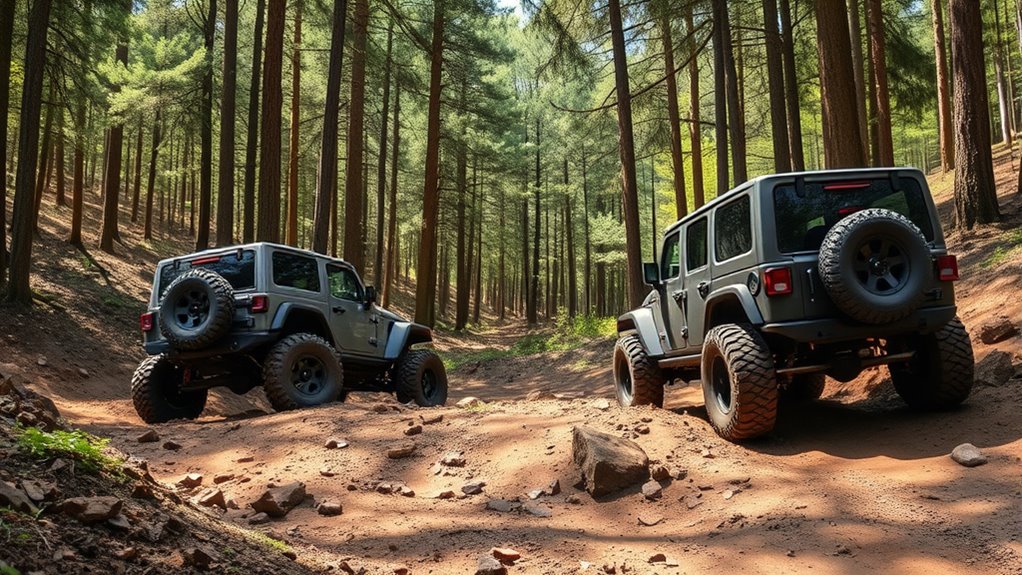
Mechanical simplicity often gives 4WD systems an edge in off-road situations because fewer moving parts mean there’s less that can break or malfunction. With fewer components, like complex transfer cases or additional driveshafts, your vehicle becomes easier to maintain and repair in remote settings. This simplicity reduces the chances of mechanical failure, which is vital when you’re far from help. Reliability is especially important when tackling tough terrains, where breakdowns can leave you stranded. A straightforward 2WD system typically has fewer parts and less complexity, making it more dependable over time. While 4WD offers traction advantages, its mechanical complexity can sometimes lead to more issues, especially if not properly maintained. Ultimately, mechanical simplicity can save you time, money, and frustration on your off-road adventures. Additionally, understanding the side effects of juice detox can help you make healthier choices during your off-road trips.
Maneuverability and Agility Off-Road
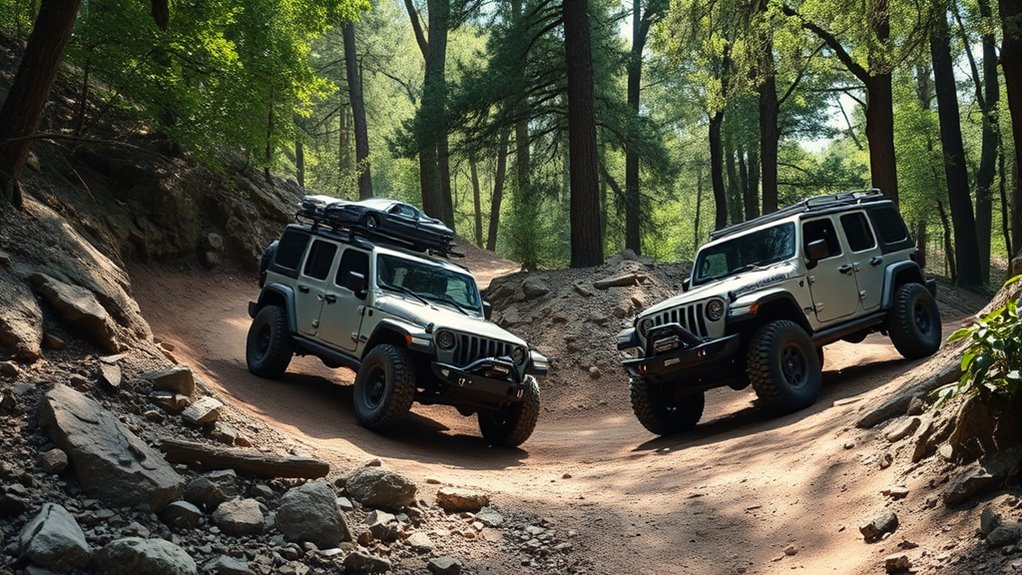
When off-road, your ability to turn sharply and stay in control makes all the difference. The way your vehicle responds to terrain changes can either boost your confidence or leave you struggling. Let’s explore how 4WD and 2WD compare in maneuverability and agility.
Turning Radius and Control
Off-road maneuverability heavily depends on a vehicle’s turning radius and control, which determine how easily you can navigate tight spots and tricky terrain. A smaller turning radius lets you make sharper turns, essential when maneuvering narrow trails or avoiding obstacles. With better control, you can precisely steer through uneven ground without overcorrecting or losing stability. Two-wheel drive vehicles often feature a tighter turning radius because they’re lighter and less complex, making them easier to handle in tight spots. Four-wheel drive systems, while offering superior traction, can sometimes increase turning radius due to added weight and drivetrain components. Ultimately, your ability to control your vehicle through tight turns depends on both the design of your vehicle and your skill, not just the drivetrain type. Additionally, understanding the vehicle’s wheelbase length can also influence maneuverability and how easily you can navigate challenging off-road conditions.
Response to Terrain Changes
Responding effectively to terrain changes requires a vehicle that can quickly adapt its maneuverability and agility. Off-road conditions often shift suddenly—rocky patches, loose sand, or muddy sections demand quick adjustments. A 2WD vehicle, with lighter weight and simpler drivetrain, can often react faster to these changes, allowing you to navigate tight spots or uneven terrain more easily. It tends to be more nimble, making sharp turns and quick maneuvers simpler. Conversely, 4WD systems, while providing more traction, can add weight and complexity, which may hinder rapid response. Your ability to stay flexible depends on how well your vehicle handles sudden terrain shifts. One key factor is the vehicle’s maneuverability, which significantly influences how quickly it can adapt to unpredictable environments. Ultimately, agility and maneuverability are essential for maintaining control and momentum in unpredictable off-road environments.
Fuel Efficiency and Operating Costs
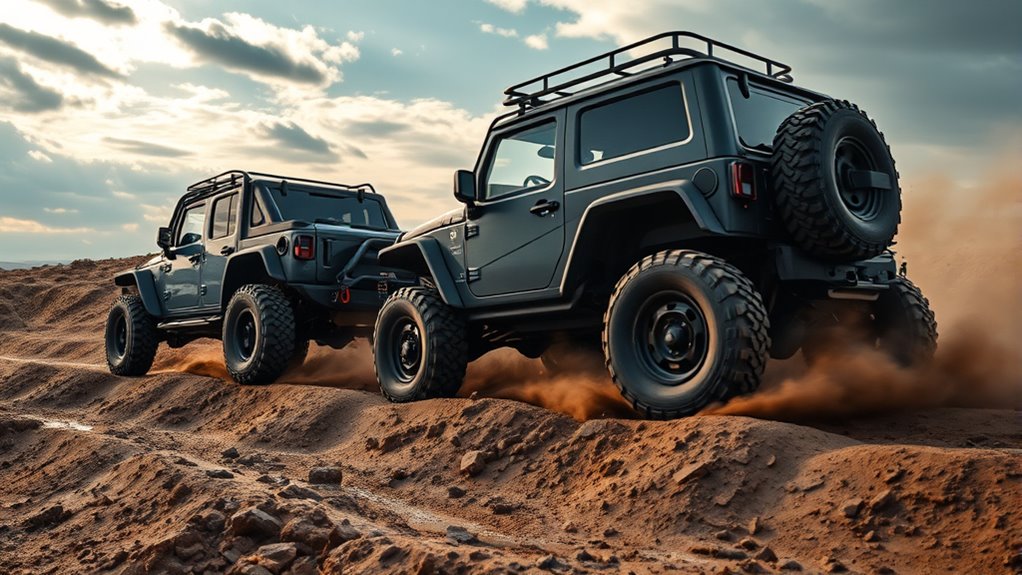
While 4WD systems offer superior traction off-road, they tend to consume more fuel and increase operating costs compared to 2WD vehicles. Engaging all four wheels adds weight and mechanical complexity, which leads to higher fuel consumption. On paved roads or light terrain, this extra power isn’t necessary, so you end up spending more at the pump without significant benefits. Additionally, 4WD systems often require more maintenance due to additional components like transfer cases and drive shafts, which can lead to higher repair costs over time. If your driving mostly involves city streets or well-maintained trails, sticking with 2WD saves you money on fuel and reduces maintenance expenses. Overall, while 4WD provides better off-road capability, it’s not always the most economical choice for everyday driving. Proper traction control can sometimes offer similar benefits without the added costs.
Situations Where 2WD Outperforms 4WD
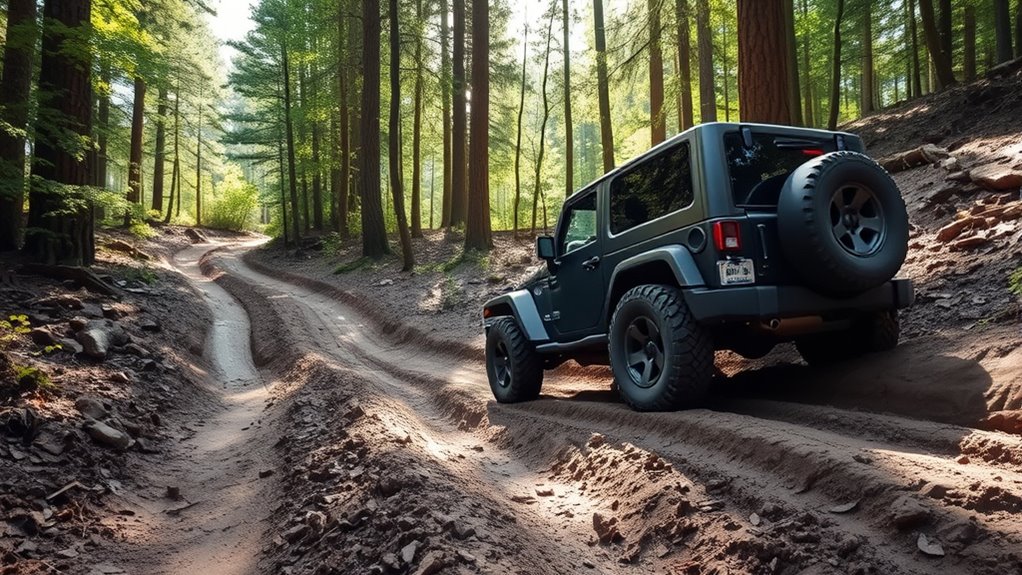
In many everyday driving situations, 2WD vehicles often outperform their 4WD counterparts regarding efficiency and ease of use. When you’re on dry, paved roads, 2WD offers better fuel economy and simpler maintenance. It’s lighter, which means less strain on your engine and lower operating costs. Plus, 2WD vehicles are easier to handle and park in urban settings. Halal certification can also influence the choice of vehicle and accessories, ensuring compliance with dietary laws.
Frequently Asked Questions
Can 4WD Systems Improve Braking Performance Off-Road?
You might wonder if 4WD systems can boost your braking off-road. While 4WD can improve traction and control, it doesn’t automatically enhance braking performance. Effective braking depends on your vehicle’s brakes, tires, and weight distribution. Using 4WD wisely helps you maintain stability during braking, especially on slippery or uneven terrain. Remember, proper technique and vehicle maintenance are key to safe, effective braking off-road.
How Does Tire Choice Impact 2WD Versus 4WD Off-Road?
Imagine your tires as the shoes of your vehicle, gripping or slipping on rough terrain. Your choice of tires dramatically influences your off-road performance, whether in 2WD or 4WD. Rugged, aggressive tires cut through mud and loose gravel better, giving you traction and confidence. Smooth tires may glide effortlessly on hard-packed surfaces but struggle in softer conditions. Selecting the right tires guarantees you’re always prepared to tackle the trail, regardless of your drivetrain.
Do Driver Skills Influence the Effectiveness of 2WD and 4WD?
Your driving skills greatly influence how effective your 2WD or 4WD system performs off-road. With good technique, you can navigate challenging terrain confidently in either mode, making the most of your vehicle’s capabilities. Experienced drivers know when to switch between 2WD and 4WD for maximum traction and control, preventing unnecessary strain on the drivetrain. So, your skill level can be the deciding factor in how well you handle off-road obstacles, regardless of your vehicle’s drive system.
Are There Specific Weather Conditions Favoring 2WD Over 4WD?
You might think 4WD always wins, but in certain weather, like light rain or dry, dusty trails, 2WD can actually be better. When roads are less slippery, 2WD’s lighter setup lets you move more nimbly without the added weight and complexity of 4WD. So, ironically, in mild conditions, sticking to 2WD can give you a smoother, quicker ride off-road, saving fuel and reducing wear.
How Does Vehicle Height Affect Off-Road Maneuverability?
When considering vehicle height, you’ll find it impacts off-road maneuverability considerably. A taller vehicle offers better ground clearance, helping you navigate over rocks and uneven terrain without getting stuck. However, it also raises your center of gravity, making you more prone to tipping or rolling on sharp turns. You need to balance height for clearance with stability to maintain control, especially on tricky trails or steep inclines.
Conclusion
So, next time you’re tackling the trails, remember that four wheels don’t always mean faster or better. Sometimes, the simplest path is the most effective. Think of 2WD as your trusted compass—lighter, more efficient, and easier to maneuver. Don’t be fooled by the allure of 4WD’s complexity; in off-road adventures, less can truly be more. After all, isn’t it the journey, not just the destination, that counts?
